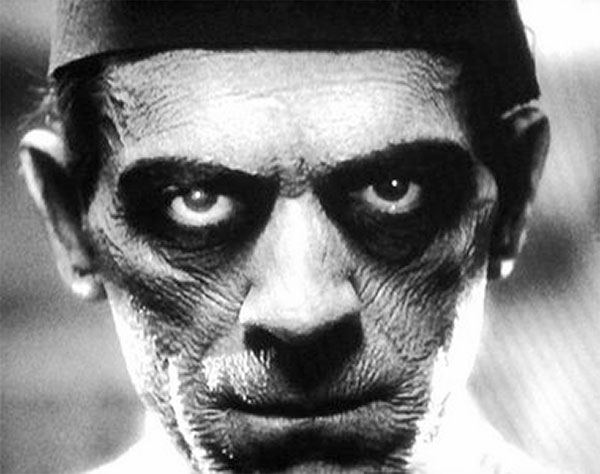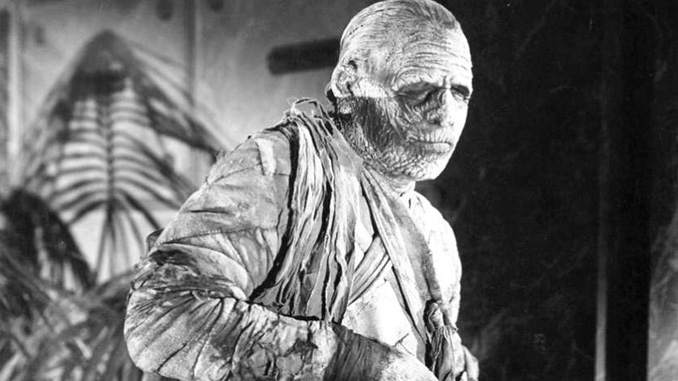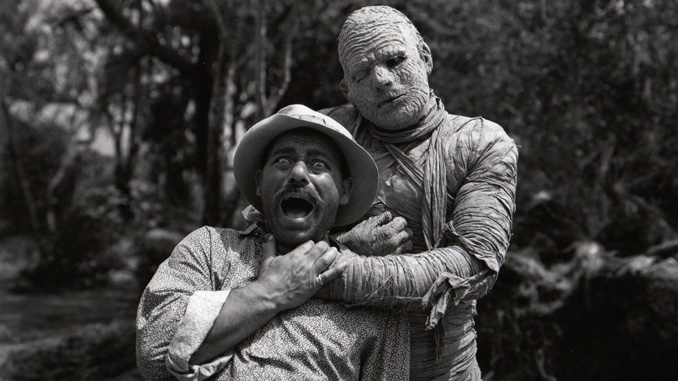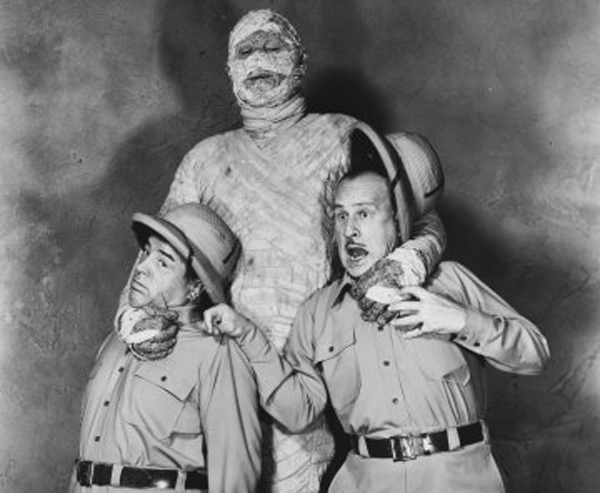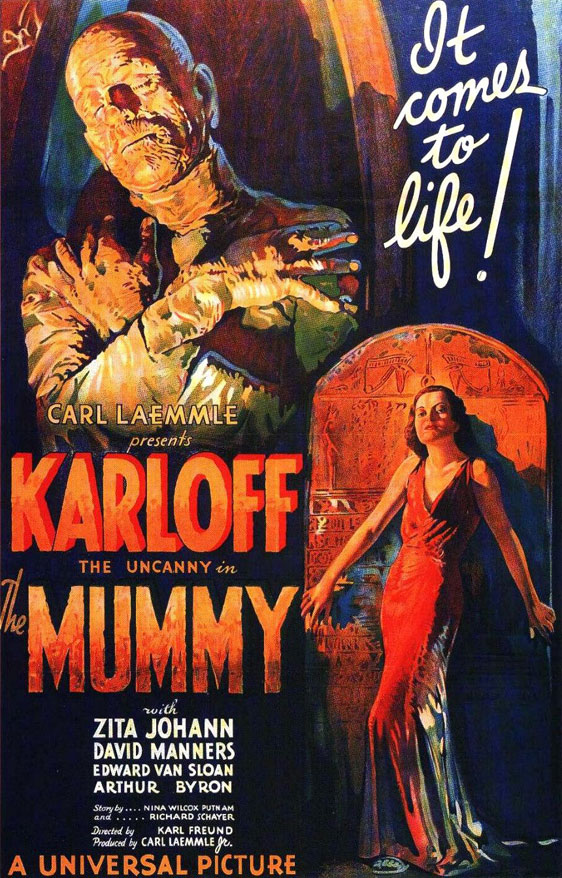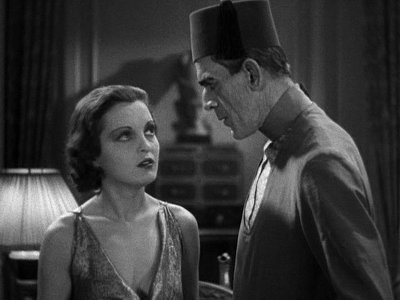
Welcome back to Memorable Movie Quotes, that column where we look at memorable quotes from some pretty cool movies, especially horror movies.
Up today it’s THE MUMMY (1932), the classic Universal monster movie that starred Boris Karloff as Imhotep, the mummy, and unlike later mummy movies in which the monster was mute and remained in its bandages, Imhotep sheds his wrappings and wreaks havoc with curses and spells which gives him plenty of dialogue, meaning in THE MUMMY there are lots of Imhotep quotes to be found.
The two most memorable things about THE MUMMY are Karl Freund’s exceedingly atmospheric direction, and Karloff’s mesmerizing performance as Imhotep, but the screenplay by John L. Balderston, who also contributed to the screenplays for DRACULA (1931), FRANKENSTEIN (1931), and THE BRIDE OF FRANKENSTEIN (1935), isn’t too shabby either.
The screenplay, based on stories by Nina Wilcox Putnam and Richard Schayer, is very similar to the story told in DRACULA. Imhotep, like Dracula, sets his sights on a young woman, Helen Grosvenor (Zita Johann), and he tries to steal her away from her love interest, Frank Whemple (David Manners), and standing in his way is the knowledgable Doctor Muller (Edward Van Sloan). David Manners and Edward Van Sloan each played similar roles in DRACULA (1931), as Manners played John Harker, and Van Sloan played Van Helsing.
But in this case Imhotep is interested in Helen Grosvenor because she’s the reincarnation of his lost love, unlike in DRACULA where Dracula, a vampire, wasn’t all that interested in love. Interestingly enough, later versions of DRACULA would use this reincarnation plot point, something that was done here in THE MUMMY, but not in the Lugosi DRACULA or in Bram Stoker’s original novel Dracula.
THE MUMMY is chock full of memorable lines of dialogue. Let’s have a listen.
After the opening credits, the eeriness begins in earnest as these words appear on-screen: This is the Scroll of Thoth. Herein are set down the magic words by which Isis raised Osiris from the dead.
The film opens in 1921 in Egypt where Sir Joseph Whemple (Arthur Byron) has just discovered the mummified remains of Imhotep. His friend and colleague Doctor Muller (Edward Van Sloan) warns him against disregarding Egyptian curses, but his eager young assistant Ralph (Bramwell Fletcher) reads the spell and unintentionally resurrects Imhotep (Boris Karloff) in one of the film’s most chilling scenes.
When Sir Joseph finds Ralph laughing maniacally and the body of the mummy missing, the youth says:
RALPH: He went for a little walk! You should have seen his face!
The story picks up ten years later when we find Sir Joseph’s son Frank (David Manners) following in his father’s footsteps in Egypt, along with fellow scientist Professor Pearson (Leonard Mudie). Here, they discuss what happened on that fateful day ten years earlier.
PEARSON: Well, Whemple, back we go to London, and what fools we’ll look. Money wasted, hole after hole dug in this blasted desert, a few beads, a few broken pots. A man needs more than hard work for this game. He needs flair, he needs luck, like your father.
FRANK: Well, in the days he used to come out here there wasn’t so much competition.
PEARSON: When he did, he found things, and once, ten years ago, he found too much.
FRANK: Was it ten years ago? Queer story that young Oxford chap he had with him going mad. You know what I think it was?
PEARSON: No. What?
FRANK: I think he went crazy, bored beyond human endurance, messing around in this sand and these rocks.
PEARSON: He was laughing when your father found him. He died laughing. In a straitjacket. Your father never explained, but when the best excavator England has turned out, a man who loves Egypt, said he’d never come back here, that meant something.
Imhotep arrives using the alias Ardath Bey, and he leads Frank and Pearson to the remains of the mummy Ankh-es-en-Amon, Imhotep’s long-lost love. Later, Imhotep travels to the British Museum where he hopes to raise his love from the dead. While there, he meets Sir Joseph Whemple who is overjoyed to meet him since he’s the one responsible for this grand exhibit. He reaches for Imhotep’s arm, who abruptly pulls away, saying:
IMHOTEP: Excuse me… I dislike being touched… an Eastern prejudice.
Later, Frank entertains Helen Grosvenor, and this conversation sets up one of her better lines in the movie:
FRANK: Stuck in the desert for two months, and was it hot! That tomb…
HELEN: What tomb?
FRANK: Surely you read about the princess?
HELEN: So you did that.
FRANK: Yes. The fourteen steps down and the unbroken seals were thrilling. But when we came to handle all her clothes and her jewels and her toilet things – you know they buried everything with them that they used in life? – well, when we came to unwrap the girl herself…
HELEN: How could you do that?
FRANK: Had to! Science, you know. Well after we’d worked among her things, I felt as if I’d known her. But when we got the wrappings off, and I saw her face… you’ll think me silly, but I sort of fell in love with her.
HELEN Do you have to open graves to find girls to fall in love with?
When Imhotep meets Helen, he recognizes her right away as the reincarnation of Anck-es-en-Amon.
IMHOTEP: Have we not met before, Miss Grosvenor?
HELEN: No. I don’t think so. I don’t think one would forget meeting you, Ardath Bey.
IMHOTEP: Then I am mistaken.
In one of the film’s most intense scenes, Imhotep tries to force Sir Joseph Whemple and Doctor Muller to give him the Scroll of Thoth:
IMHOTEP: That scroll is my property. I bought it from a dealer. It is here in this house. I presume in that room. (Turns to Joseph Whemple and utters words to a curse.)
DR. MULLER: We have foreseen this! The scroll is in safe hands. It will be destroyed the minute it is known that harm has come to us.
IMHOTEP: You have studied our ancient arts and you know that you cannot harm me. You also know that you must return that scroll to me or die. Now tell that weak fool to get that scroll wherever it is and hand it to his Nubian servant.
SIR JOSEPH: The Nubian?
DR. MULLER: The ancient blood—and so you have made him your slave. If I could get my hands on you, I’d break your dried flesh to pieces, but your power is too strong.
Eventually, Imhotep gets both the Scroll of Thoth and Helen, and as he puts her in a trance, he prepares to reveal to her their history:
IMHOTEP: You will not remember what I show you now, and yet I shall awaken memories of love… and crime… and death…
The flashback sequence, which shows the tragic end to their love story, and chronicles how Imhotep first became a mummy, is one of the most atmospheric and memorable sequences in the entire movie. In order to give it a long ago feel, director Karl Freund shot it like a silent movie, and so there’s no sound other than the haunting music and Karloff’s effective voiceover narration.
Let’s have a listen:
IMHOTEP (voiceover narration): I knelt by the bed of death. My father’s last farewell. I knew the Scroll of Thoth could bring thee back to life. I dared the god’s anger and stole it.
I stole back to thy tomb to bring thee back to life. I murmured the spell that raises the dead. They broke in upon me and found me doing an unholy thing.
My father condemned me to a nameless death. The scroll he ordered buried with me that no such sacrilege might disgrace Egypt again.
A nameless grave. The slaves were killed so that none should know. The soldiers who killed them were also slain, so no friend could creep to the desert with funeral offerings for my condemned spirit.
And then, after the flashback is finished, Imhotep continues the conversation, first while Helen is still in a trance, and then after he awakens her:
IMHOTEP: Anck-es-en-Amon, my love has lasted longer than the temples of our gods. No man ever suffered as I did for you. But the rest you may not know. Not until you are about to pass through the great night of terror and triumph. Until you are ready to face moments of horror for an eternity of love. Until I send death to your spirit that has wandered through so many forms and so many ages.
But before that, Bast must again send forth death, death to that boy whose love is creeping into your heart, love that would keep you from myself. Love that might bring sickness and even death to you— awake!
HELEN: Have I been asleep? I had strange dreams. Dreams of ancient Egypt, I think. There was someone like you in them.
IMHOTEP: My pool is sometimes troubled. One sees strange fantasies in the water, but they pass like dreams.
And we finish with a line near the end of the film, when Helen realizes Imhotep’s intentions, and admits her conflict, that she understands she’s two different people, but one of those persons is alive and well in the here and now.
HELEN: I loved you once, but now you belong with the dead. I am Anck-es-en-Amon, but I… I’m somebody else, too. I want to live, even in this strange new world.
THE MUMMY is one of Universal’s best classic monster movies, and it features a phenomenal performance by Boris Karloff as Imhotep.
I hope you enjoyed these quotes from THE MUMMY and join me again next time when we look at quotes from another classic movie.
Thanks for reading!
—Michael
Books by Michael Arruda:
New in 2019! DARK CORNERS, Michael Arruda’s second short story collection, contains ten tales of horror, six reprints and four stories original to this collection.

Waiting for you in Dark Corners are tales of vampires, monsters, werewolves, demonic circus animals, and eternal darkness. Be prepared to be both frightened and entertained. You never know what you will find lurking in dark corners.
Ebook: $3.99. Available at http://www.crossroadspress.com and at Amazon.com. Print on demand version available at https://www.amazon.com/dp/1949914437.
TIME FRAME, science fiction novel by Michael Arruda.

How far would you go to save your family? Would you change the course of time? That’s the decision facing Adam Cabral in this mind-bending science fiction adventure by Michael Arruda.
Ebook version: $2.99. Available at http://www.crossroadpress.com. Print version: $18.00. Includes postage! Email your order request to mjarruda33@gmail.com. Also available at Amazon.com.
IN THE SPOOKLIGHT, movie review collection by Michael Arruda.
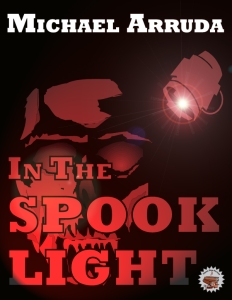
Michael Arruda reviews horror movies throughout history, from the silent classics of the 1920s, Universal horror from the 1930s-40s, Hammer Films of the 1950s-70s, all the way through the instant classics of today. If you like to read about horror movies, this is the book for you!
Ebook version: $4.99. Available at http://www.crossroadpress.com. Print version: $18.00. Includes postage. Email your order request to mjarruda33@gmail.com. Also available at Amazon.com.
FOR THE LOVE OF HORROR, first short story collection by Michael Arruda.

Print cover
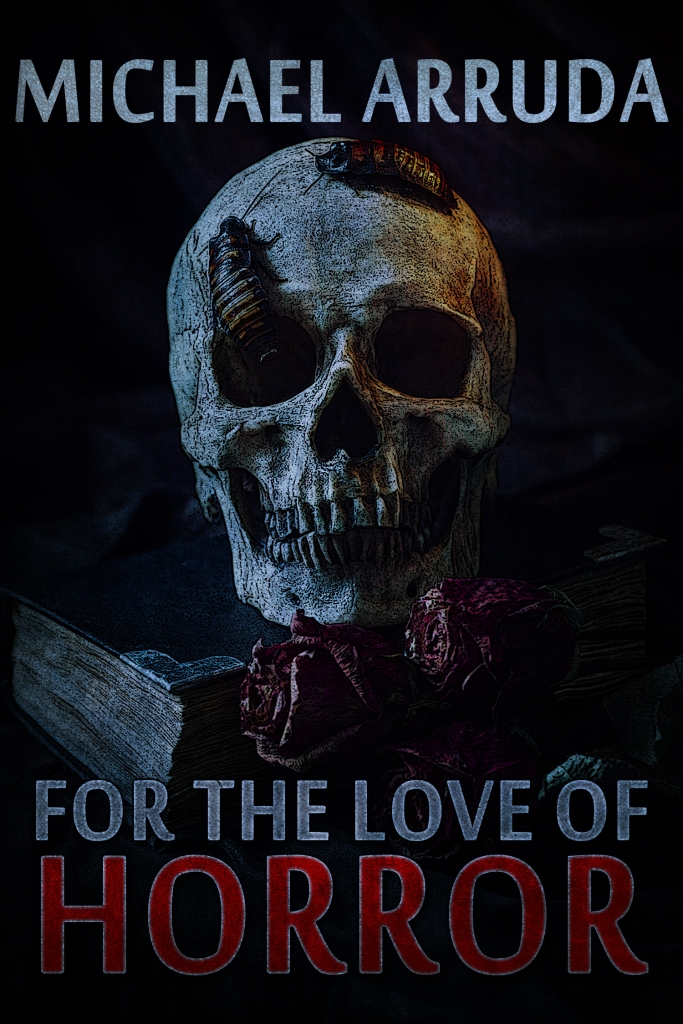
Ebook cover
Michael Arruda’s first short story collection, featuring a wraparound story which links all the tales together, asks the question: can you have a relationship when your partner is surrounded by the supernatural? If you thought normal relationships were difficult, wait to you read about what the folks in these stories have to deal with. For the love of horror!
Ebook version: $4.99. Available at http://www.crossroadpress.com. Print version: $18.00. Includes postage. Email your order request to mjarruda33@gmail.com. Also available at Amazon.com.


